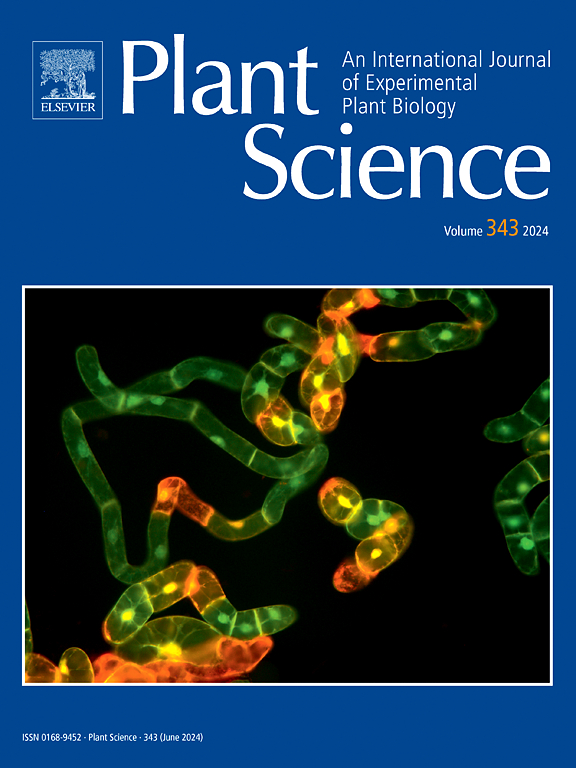GmHSP40.1, a nuclear-localized soybean J domain protein, participates in regulation of flowering time through interacting with EMF1 and JMJ14
IF 4.2
2区 生物学
Q2 BIOCHEMISTRY & MOLECULAR BIOLOGY
引用次数: 0
Abstract
Heat shock protein 40s (HSP40s) are a group of J domain proteins (JDPs), which serve as co-chaperones for heat shock protein 70s. We previously reported that over-expression of a soybean class C JDP, GmHSP40.1, in Arabidopsis activated defense responses. Surprisingly, a significantly delayed flowering phenotype was also observed for the GmHSP40.1-overexpressing (OE) lines. We provided evidence that the late-flowering phenotype observed in the GmHSP40.1-OE lines was not due to impaired pri-miRNA processing and pre-mRNA splicing. Instead, we found that GmHSP40.1 interacted and co-localized with both EMF1 and JMJ14, two major components in the EMF1 complex (EMF1c), which plays a key role in depositing and maintaining the H3K27me3 modification in the FT locus. Consistent with these interactions, the H3K27me3 modification at FT chromatin was significantly increased, whereas the H3K27me3 modification at FLC locus was significantly decreased in the GmHSP40.1-OE line compared with the wde-type Col-0. Interestingly, the H3K4me3 modification was just opposite to H3K27me3 modification at FT and FLC loci, suggesting an antagonistic relationship between these two modifications. Accordingly, the expression of FT and FLC was significantly reduced and increased, respectively, in the GmHSP40.1-OE line compared with that of Col-0. Lastly, we showed that both EMF1 and JMJ14 are genetically epistatic to GmHSP40.1-overexpression. Together, our results revealed that GmHSP40.1 negatively regulates flowering time through promoting the function of EMF1c via interacting with both EMF1 and JMJ14.
GmHSP40.1是一个核定位的大豆J结构域蛋白,通过与EMF1和JMJ14相互作用参与开花时间的调控。
热休克蛋白40s (HSP40s)是一组J结构域蛋白(jdp),是热休克蛋白70s的共伴侣蛋白。我们之前报道过,在拟南芥中,大豆C类JDP GmHSP40.1的过表达激活了防御反应。令人惊讶的是,gmhsp40.1过表达(OE)系也观察到明显延迟开花表型。我们提供的证据表明,在GmHSP40.1-OE系中观察到的晚花表型不是由于pri-miRNA加工和pre-mRNA剪接受损。相反,我们发现GmHSP40.1与EMF1复合物(EMF1c)中的两个主要成分EMF1和JMJ14相互作用并共定位,EMF1复合物在FT位点沉积和维持H3K27me3修饰中起关键作用。与这些相互作用相一致,GmHSP40.1-OE系FT染色质上的H3K27me3修饰显著增加,而FLC位点上的H3K27me3修饰与wde型col0相比显著降低。有趣的是,H3K4me3修饰恰好与FT和FLC位点的H3K27me3修饰相反,这表明这两种修饰之间存在拮抗关系。因此,与Col-0相比,GmHSP40.1-OE细胞系中FT和FLC的表达分别显著降低和升高。最后,我们发现EMF1和JMJ14对gmhsp40.1过表达具有遗传上位性。总之,我们的研究结果表明,GmHSP40.1通过与EMF1和JMJ14相互作用,通过促进EMF1c的功能,负向调节开花时间。
本文章由计算机程序翻译,如有差异,请以英文原文为准。
求助全文
约1分钟内获得全文
求助全文
来源期刊

Plant Science
生物-生化与分子生物学
CiteScore
9.10
自引率
1.90%
发文量
322
审稿时长
33 days
期刊介绍:
Plant Science will publish in the minimum of time, research manuscripts as well as commissioned reviews and commentaries recommended by its referees in all areas of experimental plant biology with emphasis in the broad areas of genomics, proteomics, biochemistry (including enzymology), physiology, cell biology, development, genetics, functional plant breeding, systems biology and the interaction of plants with the environment.
Manuscripts for full consideration should be written concisely and essentially as a final report. The main criterion for publication is that the manuscript must contain original and significant insights that lead to a better understanding of fundamental plant biology. Papers centering on plant cell culture should be of interest to a wide audience and methods employed result in a substantial improvement over existing established techniques and approaches. Methods papers are welcome only when the technique(s) described is novel or provides a major advancement of established protocols.
 求助内容:
求助内容: 应助结果提醒方式:
应助结果提醒方式:


